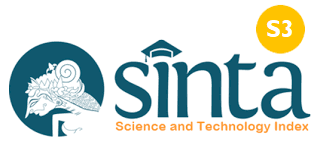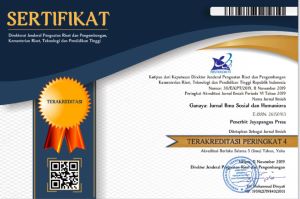Tradisi Pembacaan Teks-Teks Agama dan Sosiologi Dakwah Lingkungan di Lombok, Indonesia
(Studi Kasus di Bayan dan Sembalun)
DOI:
https://doi.org/10.37329/ganaya.v5i4.2743Keywords:
Religious Texts, Kyai, Ustadz, Environmental FaithAbstract
In the history of Islamic development in Lombok, texts, cultures and prophecies played a significant role in the growth of environmentally friendly Islam. Religious texts, as well as sources from the Ancient Scriptures, or from the yellow books, are continuously read in some villages in Lombok. In Lombok, these two types of texts are still read and are sources of witness to local religious figures, such as Kyai and Ustadz, in Bayan and Sembalun. Among the texts read are Qashais al-Anbiya, Kitab of Fikih and the Kitab of Imam Shafi. As a village that still applies the customs and traditions of the Sasaks, Bayan and Sembalun synergize elements in the tradition with the teachings in Islam holistically. To find a form of synergy between the two, a method of dermatological research with an ethnographic approach was chosen to be used in this study. The ethnographic approach itself is a type of approach that finds in-depth data through the process of engaging observations and in- depth interviews. The leaders of Adi, Kyai, Ustad and the villagers were observed and interviewed to learn about the religious texts and the development of religious environments in Bayan and Sembalun.References
Ariadi, L. M. (2013). Haji Sasak: Sebuah Potret Dialektika Haji dan Kebudayaan Lokal. IMPRESSA Publishing.
Ariadi, L. M. (2017). Islam Sasak: Sebuah Manifestasi Fikih Budaya. Schemata, 6(2), 842.
Ariadi, L. M., Quddus, A., & Asyari, A. (2020). Manuscripts, Sharia and Religious Freedom Values Growth in West Nusa Tenggara. Humanities & Social Sciences Reviews, 8(1), 183–191.
Arzaki, D. (2001). Nilai-nilai Agama dan Kearifan Budaya Lokal Suku Bangsa Sasak Dalam Pluralisme Kehidupan Bermasyarakat: Sebuah Kajian Antropologis-Sosiologis-Agamis. Pokja Redam.
Azhar, L. M. (1997). Sejarah Daerah Lombok: Arya Banjar Getas. Yaspen.
Badan Pusat Statistik Prop. NTB. (2015). NTB Dalam Angka 2015. UD Fajar Indah.
Budiwanti, E. (2014). The purification movement in Bayan, North Lombok: Orthodox Islam vis-à-vis religious syncretism. In Between Harmony and Discrimination: Negotiating Religious Identities within Majority-Minority Relationships in Bali and Lombok (pp. 144–161). Brill.
Departemen Pendidikan dan Kebudayaan NTB. (1978). Adat Istiadat Daerah Nusa Tenggara Barat. Proyek Penelitian dan Pencatatan Kebudayaan Daerah.
Departemen Pendidikan dan Kebudayaan NTB. (1990). Bunga Rampai Kutipan Naskah Lama dan Aspek Pengetahuannya. Proyek Kajian Kebudayaan Daerah.
Habiburrahman, L. (2019). Strategi dan Fungsi Linguistik Kekuasaan dalam Naskah Babad Lombok. MABASAN, 5(2), 35–47.
Inglis, F. (2015). Geertz, Clifford (1926-2006). In International Encyclopedia of the Social & Behavioral Sciences: Second Edition (pp. 661–665). Elsevier Inc.
Kantor Desa Sembalun. (2015). Monografi Desa Sembalun.
Koopman, J. (2023). Subawe, traditional knowledge, and faith-based organisations promoting social capital and disaster preparedness: A Lombok, Indonesia case study. International Journal of Disaster Risk Reduction, 94.
Lukman, L. (2004). Lombok. Mataram: Pokja.
Muliadi, M., & Komarudin, D. (2020). The Islamic Culture of “Wetu Telu Islam” Affecting Social Religion in Lombok. El Harakah (terakreditasi), 22(1), 97–115.
Nengah, A. (2010). Ajeg Bali, Gerakan, Identitas Kultural, dan Globalisasi. Yogyakarta: LKiS.
Nordholt, H. S. (2007). Politik Lokal di Indonesia. Yogyakarta: Yayasan Obor.
Sajila Apjan, S. (2019). Tolak Bala: A Relation Between Islam and Tradition. Journal of Islamic Studies and Humanities, 4(1), 87–98.
Salam, L. S. (1992). Lombok Pulau Perawan. Mataram: Kuning Mas.
Sudirman. (2007). Gumi Sasak dalam Sejarah. Mataram: KSU Prima Guna.
Tilaar, H. A. R. (1986). Pendidikan, Kebudayaan, Dan Masyarakat Madani Indonesia. Bandung: PT Remaja Rosdakarya.
Wirata, I. W. (2017). Perempuan Dalam Cerita Naskah Islam Lokal (Suku Sasak) Di Lombok (Pendekatan Sosiologi). Mudra Jurnal Seni Budaya, 31(2).
Downloads
Published
How to Cite
Issue
Section
License
Copyright (c) 2022 Nazar Naamy (Author)

This work is licensed under a Creative Commons Attribution-ShareAlike 4.0 International License.
An author who publishes in the Ganaya : Jurnal Ilmu Sosial dan Humaniora agrees to the following terms:
- Author retains the copyright and grants the journal the right of first publication of the work simultaneously licensed under the Creative Commons Attribution-ShareAlike 4.0 License that allows others to share the work with an acknowledgement of the work's authorship and initial publication in this journal
- Author is able to enter into separate, additional contractual arrangements for the non-exclusive distribution of the journal's published version of the work (e.g., post it to an institutional repository or publish it in a book) with the acknowledgement of its initial publication in this journal.
- Author is permitted and encouraged to post his/her work online (e.g., in institutional repositories or on their website) prior to and during the submission process, as it can lead to productive exchanges, as well as earlier and greater citation of the published work (See The Effect of Open Access).
Read more about the Creative Commons Attribution-ShareAlike 4.0 Licence here: https://creativecommons.org/licenses/by-sa/4.0/.








